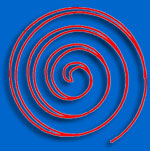
Quantum Measurement
Measurement
Statistics & Uncertainty Estimations
Heisenberg's Uncertainty Principle
Relativity Theory & Causality
Spin, Polarization, and Mixed States
Bell's Inequality
- Stern-Gerlach Experiment
- Simple Math Relationship
- Consequence of EPR Experiments
- Questions
Bell's Inequality
Stern-Gerlach Experiment
 We
have already seen how the spin of the electron is quantized, once the
electron is placed in an external magnetic field. In their experiment,
German physicists Stern and Gerlach created a region of non-uniform
magnetic field and passed through it a beam of atoms (for our purposes
we can think of this beam as a beam of electrons, instead). What they
expected to observe was a sort of fanning of the beam. This is because,
depending on the orientation of the magnetic moment vector, each
individual atom (or electron) would experience a force related to the
orientation of its magnetic moment resulting in a vertical deflection of
the beam. They also expected this deflection to be continuous for their
"un-polarized" beam. Instead they observed that the beam separated into
only two vertical directions (two beams: an "up" and a "down" beam) once
it traversed through the non-uniform magnetic field. This "up" and
"down" beams suggest that the atom's magnetic moment vector must have
been either "up" or "down" and in no other orientation; i.e. quantized
in the vertical direction. But what if the magnet were to be rotated to
instead create a non-uniform magnetic field in the horizontal direction?
They found that the beam separates into still two beams but these split
horizontally; a "right" and a "left" beam! In fact, any orientation of
this non-uniform magnetic field is shown to create just two beams along
the direction of the magnetic field; i.e. electron's spin is quantized
in the direction of the external magnetic field.
We
have already seen how the spin of the electron is quantized, once the
electron is placed in an external magnetic field. In their experiment,
German physicists Stern and Gerlach created a region of non-uniform
magnetic field and passed through it a beam of atoms (for our purposes
we can think of this beam as a beam of electrons, instead). What they
expected to observe was a sort of fanning of the beam. This is because,
depending on the orientation of the magnetic moment vector, each
individual atom (or electron) would experience a force related to the
orientation of its magnetic moment resulting in a vertical deflection of
the beam. They also expected this deflection to be continuous for their
"un-polarized" beam. Instead they observed that the beam separated into
only two vertical directions (two beams: an "up" and a "down" beam) once
it traversed through the non-uniform magnetic field. This "up" and
"down" beams suggest that the atom's magnetic moment vector must have
been either "up" or "down" and in no other orientation; i.e. quantized
in the vertical direction. But what if the magnet were to be rotated to
instead create a non-uniform magnetic field in the horizontal direction?
They found that the beam separates into still two beams but these split
horizontally; a "right" and a "left" beam! In fact, any orientation of
this non-uniform magnetic field is shown to create just two beams along
the direction of the magnetic field; i.e. electron's spin is quantized
in the direction of the external magnetic field.
Try the JAVA applet developed by the Oregon State:
Do the following:
- Z-SG: what fraction of spin 1/2 particles have spin up? What fraction have spin down?
- Z-SG followed by an X-SG: What fraction have spin +x (up)? How many -x (down)?
- Out put of 2, above's, with spin +x (up) now go through a third SG, a Z- SG. What fraction spin +z (up) now?
What happens if two or three of such magnets were to be used to check the "spin" of electrons? For our discussion purposes let us call a magnet of the type used in the Stern & Gerlach's experiment a SG-magnet. Now, it turns out that a vertically oriented SG-magnet creates an Up and a Down beam. A second SG-magnet oriented in any direction other than vertically will create two beams out of either the Up or the Down electrons. (A second SG-magnet analyzing the Up beam will find that all of the electrons are indeed Up; i.e. this beam will no longer separate into two beams.) A third SG-magnet in an orientation other than the one of the second magnet also creates two beams, even if it is in the vertical orientation! These experiments seem to suggest that when an electron is placed in an external magnetic field its spin can align parallel or anti-parallel to the field direction with a 50-50 probability. But these two are the only possible spin directions. This property (attribute) of the electron - its spin direction - doesn't stay with the electron, as does, say, its charge or its mass. We can call a spin "up" electron a spin-up electron only after we've just checked for vertical spin; a horizontal spin measurement "erases" the vertical spin property. To get more familiarity with this type of measurement try playing with the simulation of Stern-Gerlach experiments, courtesy of David McIntyre of Oregon State University: Spins Java Applet at: http://www.physics.orst.edu/paradigm5/spins/
Simple Math Relationship
 Evidently,
we cannot say that an electron that is going through a horizontal SG-magnet
is a spin up (or a spin down) electron. But could we say that it is
either a spin up or a spin down? Clearly, our experiment checking for
vertical spin has no other possibility! Well, it turns out that we
cannot make such assumptions! To see how such a supposition can be
tested, let us consider the experimental arrangement that includes a
source of correlated electrons pairs, four SG magnets, and four
detectors. The source creates separate pairs of electrons that have a
total spin of zero. That is to say, if one electron in the pair has a
spin Up, its other pair has a spin Down. These electrons travel in
opposite directions so that the total momentum of the pair is also zero.
Each of these electrons is then send through one of two SG magnet
randomly, and in this way its spin is measured. Let us label these SG
magnets A, B, C, and D and arrange them so that one of the electrons in
the pair goes through, say, A and B while the other goes through C and
D. Now, if the electron that goes through A has its spin Up, then we
record a value of +1 for this measurement; but if its spin turns out to
be Down, then we record a value of -1. The same way we record values of
+1 and -1 for when an electron goes through the other three SG magnets
(this is all independent of the SG's orientation, but for the sake of a
simpler discussion let us assume that all magnets are oriented
vertically). This means then that for any electron pair we record a +1
for one electron and a -1 for the other, independent of which SG magnet
any electron goes through. Is this correct? To check this assumption
(why an assumption?) let us consider the following algebraic expression:
X = A·C + B·C +
A·D - B·D where
A, B, C, and D represent the SG magnets' assigned values of +1 and
-1when a magnet records an Up versus a Down spin. So, for example, in a
case that one electron goes through A and is found to be Up and the
other goes through D and is found to be Down, then A = +1 and D = -1. Of
course, the other two variables, B and C, have not been assigned a value
for this electron pair, but their values are either +1 or -1 each.
What's significant here
Evidently,
we cannot say that an electron that is going through a horizontal SG-magnet
is a spin up (or a spin down) electron. But could we say that it is
either a spin up or a spin down? Clearly, our experiment checking for
vertical spin has no other possibility! Well, it turns out that we
cannot make such assumptions! To see how such a supposition can be
tested, let us consider the experimental arrangement that includes a
source of correlated electrons pairs, four SG magnets, and four
detectors. The source creates separate pairs of electrons that have a
total spin of zero. That is to say, if one electron in the pair has a
spin Up, its other pair has a spin Down. These electrons travel in
opposite directions so that the total momentum of the pair is also zero.
Each of these electrons is then send through one of two SG magnet
randomly, and in this way its spin is measured. Let us label these SG
magnets A, B, C, and D and arrange them so that one of the electrons in
the pair goes through, say, A and B while the other goes through C and
D. Now, if the electron that goes through A has its spin Up, then we
record a value of +1 for this measurement; but if its spin turns out to
be Down, then we record a value of -1. The same way we record values of
+1 and -1 for when an electron goes through the other three SG magnets
(this is all independent of the SG's orientation, but for the sake of a
simpler discussion let us assume that all magnets are oriented
vertically). This means then that for any electron pair we record a +1
for one electron and a -1 for the other, independent of which SG magnet
any electron goes through. Is this correct? To check this assumption
(why an assumption?) let us consider the following algebraic expression:
X = A·C + B·C +
A·D - B·D where
A, B, C, and D represent the SG magnets' assigned values of +1 and
-1when a magnet records an Up versus a Down spin. So, for example, in a
case that one electron goes through A and is found to be Up and the
other goes through D and is found to be Down, then A = +1 and D = -1. Of
course, the other two variables, B and C, have not been assigned a value
for this electron pair, but their values are either +1 or -1 each.
What's significant here
 is
that independent of which magnet any electron of any pair goes through
and independent of what spin it has, the value of X, above, is either +2
or -2. This is of course because the algebraic expression for X was
cooked up to give us this result! What value do we expect to obtain for
X after a large number of trials? If we assume that the electron pair
are generated randomly and each is send through one of its two possible
SG magnets randomly, then we expect as many +1 as -1 values for any of
the four SG magnets A, B, C, and D. That is to say, A must have as many
+1 value occurrences as for its -1 value occurrences; the same of the
rest of the three SG magnet measurements. As a result, the summed
average of X must be zero. But when these measurements are performed, it
is found that X takes on an average value that is almost as large as 3.
(This happens despite of the fact that electron pairs are verified to be
generated randomly and each is send to one of its two SG magnets
randomly, but for a special choice of angles of the SG magnets.) So,
this result tells us that we cannot assume that electron's spin is Up or
Down without performing a measurement despite the fact that when we make
the measurement we find that it is Up or Down!
is
that independent of which magnet any electron of any pair goes through
and independent of what spin it has, the value of X, above, is either +2
or -2. This is of course because the algebraic expression for X was
cooked up to give us this result! What value do we expect to obtain for
X after a large number of trials? If we assume that the electron pair
are generated randomly and each is send through one of its two possible
SG magnets randomly, then we expect as many +1 as -1 values for any of
the four SG magnets A, B, C, and D. That is to say, A must have as many
+1 value occurrences as for its -1 value occurrences; the same of the
rest of the three SG magnet measurements. As a result, the summed
average of X must be zero. But when these measurements are performed, it
is found that X takes on an average value that is almost as large as 3.
(This happens despite of the fact that electron pairs are verified to be
generated randomly and each is send to one of its two SG magnets
randomly, but for a special choice of angles of the SG magnets.) So,
this result tells us that we cannot assume that electron's spin is Up or
Down without performing a measurement despite the fact that when we make
the measurement we find that it is Up or Down!
Consequence of EPR Experiments
 The
above mathematical relation is just one way that we could test the
reality as prescribed by nature. To-date many different versions of EPR
experiments have been performed and have verified that our notion, based
on our every day experience in our macroscopic world, that physical
reality has "pre-ordained" measurable values does not apply, at least in
the microscopic world. This rather odd result is not only in accordance
with, but it is also predicted by the theory of quantum mechanics.
According to quantum mechanics a mixed state evolves in time as a mixed
state. But when we make a measurement the mixed state "collapses" into
one of its possible definite values. Every one seems to agree with these
two facts; i.e. that 1) nature violates Bell's inequality, and 2)
quantum mechanics is the theory that correctly describes the microscopic
world. But there is no clear agreement on what this really means. Some
seem to believe that these results tell us that in the absence of a
measurement there is no reality. Others go further by saying that it is
the measurement that create the result. In the context of the classical
statement: "When a tree falls in a forest will it make a sound, if no
one is there to hear it?" the first group will say that there will be no
sound and the second group believe that it is the presence of the
observer that causes the fall of the tree to make a sound. No matter
which of these descriptions one believes (or not) there are two
important consequences of EPR experiments namely that two previously
held doctrines of our physical reality are violated: causality
and local reality. We have already discussed one quantum eraser
type experiment; other disturbing experiments that demonstrate the above
mentioned violations include Interaction-free Measurements, Quantum
Cryptography, and Quantum Teleportation. In the context of these new
types of measurements we see that despite the oddness that the quantum
mechanical world has created for us, it has clearly expanded our scope
of reality. Some of these, seemingly X-file physics, have already
produced applications. See, for example: quantum applications of
correlated photon pairs in
Dr. Alan Migdall's Lab at NIST and
Professor B. Saleh's Center at
Boston University (go to Research). For an online tutorial and a
rather cool site see QuBIT the
publication of Center for Quantum Computation at Oxford University.
The
above mathematical relation is just one way that we could test the
reality as prescribed by nature. To-date many different versions of EPR
experiments have been performed and have verified that our notion, based
on our every day experience in our macroscopic world, that physical
reality has "pre-ordained" measurable values does not apply, at least in
the microscopic world. This rather odd result is not only in accordance
with, but it is also predicted by the theory of quantum mechanics.
According to quantum mechanics a mixed state evolves in time as a mixed
state. But when we make a measurement the mixed state "collapses" into
one of its possible definite values. Every one seems to agree with these
two facts; i.e. that 1) nature violates Bell's inequality, and 2)
quantum mechanics is the theory that correctly describes the microscopic
world. But there is no clear agreement on what this really means. Some
seem to believe that these results tell us that in the absence of a
measurement there is no reality. Others go further by saying that it is
the measurement that create the result. In the context of the classical
statement: "When a tree falls in a forest will it make a sound, if no
one is there to hear it?" the first group will say that there will be no
sound and the second group believe that it is the presence of the
observer that causes the fall of the tree to make a sound. No matter
which of these descriptions one believes (or not) there are two
important consequences of EPR experiments namely that two previously
held doctrines of our physical reality are violated: causality
and local reality. We have already discussed one quantum eraser
type experiment; other disturbing experiments that demonstrate the above
mentioned violations include Interaction-free Measurements, Quantum
Cryptography, and Quantum Teleportation. In the context of these new
types of measurements we see that despite the oddness that the quantum
mechanical world has created for us, it has clearly expanded our scope
of reality. Some of these, seemingly X-file physics, have already
produced applications. See, for example: quantum applications of
correlated photon pairs in
Dr. Alan Migdall's Lab at NIST and
Professor B. Saleh's Center at
Boston University (go to Research). For an online tutorial and a
rather cool site see QuBIT the
publication of Center for Quantum Computation at Oxford University.
